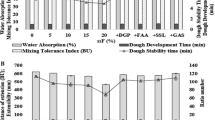Abstract
The aim of the present study was to develop breads by incorporating Spirulina platensis powder and to study their organoleptic acceptability, antioxidant activity, storage conditions and shelf life of value added acceptable breads. Spirulina platensis powder was mixed with wheat flour at different levels (2, 4, 6 and 8%) to prepare nutritive breads. Breads were developed and organoleptic evaluations were performed to find out the most appropriate level of supplementation of Spirulina platensis powder. The results showed that 6% Spirulina supplemented breads provided higher contents of total phenolic content (1.79 mg GAE/g) and antioxidant activity (16.51%). On the basis of organoleptic characteristics, overall acceptability scores indicate that Spirulina incorporated breads can be stored up to 2 days at room temperature and up to 4 days at refrigeration temperature without any preservatives. Fat acidity content and total bacterial count were found increased as time period increased but did not exceed the acceptable limit as given by BIS (Bureau of Indian Standards). Spirulina supplements are available in the market but normally people does not consume it may be because of less awareness or other reasons but if this super food is incorporated in food products like bread, which is consumed by everyone will aid to food security and malnutrition of developing countries.
Similar content being viewed by others
References
Anupama PR (2000) Value-added food: single cell protein. Biotechnol Adv 18:459–479
AOAC (2000) Official methods of analysis of association of official analytical chemists. Washington, DC
Bolanho BC, Egea MB, Jacome ALM, Campos I, Carvalho JCMD, Danesi EDG (2014) Antioxidant and nutritional potential of cookies enriched with Spirulina Platensis and sources of fibre. J Food Nutr Res 53:171–179
Guldas M, Irkin R (2010) Influence of Spirulina platensis powder on the microflora of yoghurt and acidophilus milk. Mljekarstvo 60:237–243
Harrigan WF, Margaret EM (1996) Laboratory methods in microbiology. Academic Press, London
Hatano T, Kagawa H, Yasuhara T, Okuda T (1988) Two new flavonoids and other constitutes in licorice root: their relative astringency and radical scavenging effects. Chem Pharma Bull 36:2090–2097
Matondo FK, Takaisi K, Nkuadiolandu AB, Lukusa AK (2016) Spirulina supplements improved the nutritional status of undernourished children quickly and significantly: experience from Kisantu the Democratic Republic of the Congo. Int J Pediatr 1:1–2
Mc Carty MF (2007) Clinical potential of Spirulina as source of phycocyanobilin. J Med Food 10:566–570
Navacchi MFP, Carvalho JCM, Takeuchi KP, Danesi EDG (2012) Development of cassava cake enriched with its own bran and Spirulina platensis. Acta Sci Technol 34:465–472
Nguyen PH, Scott S, Avula R, Tran LM, Menon P (2018) Trends and drives of change in the prevalence of anaemia among 1 million women and children in India, 2006 to 2016. BMJ Global Health 3:e001010
Sheoran OP, Pannu RS (1999) Statistical Package for agricultural workers. “O. P. Stat” College of Agriculture, Kaul, CCS Haryana Agricultural University, Hisar. India
Singla P, Sachdeva R, Kochhar A (2012) Impact of nutrition counseling on consumption pattern of junk foods and knowledge, attitudes and practices among adolescent girls of working mothers. J Hum Ecol 39:221–227
Singleton VL, Rossi JA (1965) Calorimetry of total phenols with phosphomolybdic-phasphotungstic acid reagents. Am J Enol Vitic 16:144–158
Acknowledgements
I would like to thanks Dr. Anju Sehrawat, Assistant Professor, Food Science and Technology, CCS Haryana Agriculture University, Hisar, Haryana for availing facilities and work place in their microbiology laboratory for the analysis of microbial counts in bread samples.
Author information
Authors and Affiliations
Corresponding author
Additional information
Publisher's Note
Springer Nature remains neutral with regard to jurisdictional claims in published maps and institutional affiliations.
Rights and permissions
About this article
Cite this article
Saharan, V., Jood, S. Effect of storage on Spirulina platensis powder supplemented breads. J Food Sci Technol 58, 978–984 (2021). https://doi.org/10.1007/s13197-020-04612-1
Revised:
Accepted:
Published:
Issue Date:
DOI: https://doi.org/10.1007/s13197-020-04612-1




